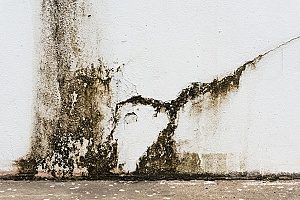 Basement flooding is possibly one of the most frustrating problems homeowners have to deal with. Flooding not only causes hundreds to thousands of dollars in water damage, but can also create an electrocution hazard if not properly dealt with. While there are a number of reasons why basements flood, the most common is an improperly graded landscape. Learn more about the common causes of basement flooding and how using fill dirt could be the answer to your basement flooding woes.
Basement flooding is possibly one of the most frustrating problems homeowners have to deal with. Flooding not only causes hundreds to thousands of dollars in water damage, but can also create an electrocution hazard if not properly dealt with. While there are a number of reasons why basements flood, the most common is an improperly graded landscape. Learn more about the common causes of basement flooding and how using fill dirt could be the answer to your basement flooding woes.
Top Causes of Basement Flooding
Basements are highly susceptible to flooding due to their position on the lowest level of buildings. If groundwater or sewer levels around your home rise above the basement floor, gravity can cause the water to seep into your basement. Cracks in the foundation can create a direct path to your basement. In some instances, a foundation drainage system may fail. Known as weeping tiles, these gravity foundation systems can degrade over time or become clogged with sediments. This prevents the groundwater around the foundation from draining naturally. Similarly, a sanitary sewer lateral can fail or become blocked, causing water to flood your basement.
While flooding is much more common during wet weather, it can also occur during periods of dry weather. Basement flooding can sometimes occur due to a water supply line break or a hot water tank failure. When the internal plumbing of a home breaks or fails, flooding can exacerbate quickly causing significant damage. Flooding during periods of wet water is fairly common, especially in homes with unfinished basements. Periods of heavy rain or snowmelt can cause water to pool around the home’s foundation. During extreme weather changes, water can flow into a home’s basement.
If you discover water pooling near your home’s foundation, you likely have grading issues. When a house is built on a lot, which path water will take should be taken into consideration. However, shifting of homes can occur over time causing water to flow to the foundation. Know that proper grading is important regardless if your home sits on a flat lot, a slight slope, or on the top or bottom of a hill. Some of the most common consequences of house grading issues include:
- Flooding during periods of heavy rain
- Drainage towards the foundation causing moisture problems
- Damp, moldy, or musty basement or crawl space
- Foundation settlement that causes cracks in the foundation
- Deterioration of foundation floors and walls
- Structural damage caused by deterioration or settlement

Signs of Water Damage in Basement
Water damage in basements is not always evident by standing water. You may need to look for other signs that could indicate possible water damage. Some red flags to look for include small pools of water in your basement or crawl space without another cause, areas of mold or mildew growth which suggests a moisture issue, trickling or dripping water from the basement walls, damp basement walls, or damp, humid air. If you notice one of more of these signs, take a closer look at your foundation and basement to check for cracks or flawed window wells. Also check your plumbing for fractured lines.
Fixing Basement Flooding Issues
Many homeowners rely on sump pumps to get rid of excess water in their basement. However, what do you do when your sump pump fails? By the time you discover the failure, your basement will have likely turned into a swimming pool. One way to help stop water from entering your basement is by installing a dry well. Your basement windows act as a weak point in your home, allowing water to enter. By installing dry wells around any windows experiencing flooding, you can improve drainage and reroute water away from the foundation.
Shrubbery planted around your home’s foundation can also cause problems. Shrubs have loose soil around it which can accumulate water. Over time, moisture can seep from the soil into your basement. The best option is to simply dig up the shrubs and replant them further away from your foundation. If you do not want to dig up your shrubs, consider building garden boxes around the plants. This allows the loose soil to push against the boxes instead of your foundation.
 Poor grading in your yard is one of the most common causes of basement flooding. Ideally, your home should be placed at the highest point on your property and the surrounding yard should slope downhill and away from the foundation. When it rains, the slope should direct the water away from the home preventing it from pooling around the foundation. Even if your home was built properly on a high point, know that soil can settle over the years causing improper grading in your yard. Address this grading issue to avoid basement flooding.
Poor grading in your yard is one of the most common causes of basement flooding. Ideally, your home should be placed at the highest point on your property and the surrounding yard should slope downhill and away from the foundation. When it rains, the slope should direct the water away from the home preventing it from pooling around the foundation. Even if your home was built properly on a high point, know that soil can settle over the years causing improper grading in your yard. Address this grading issue to avoid basement flooding.
Grading a yard may seem like a complex process but it is easier than you would think. Start by walking around the perimeter of your home to see which way your yard slopes. You can determine the level of slope by running a tight string with a level from the high point to the low point, then measure from the lowest point to the string. You can then add fill dirt to the low point. For example, if you have water draining towards your foundation, you will want to add fill dirt against your foundation which forces the water to run away from the home.
Contact a Fill Dirt Contractor
If the ground around your home’s foundation and basement wall is near level or sloping towards the house, you likely have a problem with moisture or basement flooding. One of the best long-term solutions to this issue is re-grading the landscape. Fill dirt is a necessary and essential way to create an effective slope that prevents water from pooling in areas that cause damage to your home. To learn more about using fill dirt to stop your basement from flooding or to get started with your landscape project, contact a fill dirt contractor today.









































